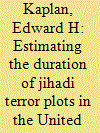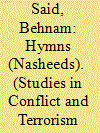| Srl | Item |
| 1 |
ID:
116220


|
|
|
|
|
| Publication |
2012.
|
| Summary/Abstract |
The number of ongoing terror plots increases with the duration of time from plot initiation until plot execution or interdiction (whichever comes first), yet no estimate of the probability distribution governing terror plot duration has appeared in the open literature. To remedy this gap, jihadi terror plots in the United States were identified from terrorism-related indictments that occurred between 11 September 2001 and 30 June 2011 in addition to successful attacks. From a review of indictments, affidavits, and other publicly available information, it was possible to identify lower and upper bounds for the initiation date of the plot in question as well as the ending date corresponding to either the arrest of the suspect(s) eventually convicted or an attempted/actual act of terror. These observations enable estimation of the duration distribution of jihadi terror plots in the United States accounting for the censoring and truncation effects inherent with these data (technical details appear in the Appendix). The estimated mean plot duration equals 270 days (standard error of mean 40 days), while 95 percent of all plots are estimated to fall between 33 and 750 days. These estimates suggest that on average, approximately three ongoing terror plots have been active in the United States at any point since 11 September 2001.
|
|
|
|
|
|
|
|
|
|
|
|
|
|
|
|
| 2 |
ID:
116218


|
|
|
|
|
| Publication |
2012.
|
| Summary/Abstract |
In this article, the authors apply the four-phase radicalization model proposed by Silber and Bhatt 1
to a case study of Australia's first convicted terrorist, Jack Roche, based on communication with Roche after his incarceration and on a qualitative analysis of his trial. In doing so, they examine the validity of the four-phase model to a case of "home grown" terrorism and dissect the role of religion in the radicalization process. To conclude, the authors find that religion plays a far lesser role in radicalization toward violent extremism than the policy response contends and this has implications for counterterrorism programs that aim to address the drivers of violent extremism.
|
|
|
|
|
|
|
|
|
|
|
|
|
|
|
|
| 3 |
ID:
116219


|
|
|
|
|
| Publication |
2012.
|
| Summary/Abstract |
This article deals with militant Islamist hymns (anasheed jihadiya; in the following simply referred to as nasheeds) as an expression of jihadist culture. In this context jihadism is regarded as a militant fraction within the Salafi movement, with which it shares goals but not means. 1
The jihadist culture as a tool to create a common jihadist identity and to mobilize new recruits is probably as important as its ideology is. In 2004 Marc Sageman made the following remarks in his book Understanding Terror Networks: "… social bonds play a more important role in the emergence of the global Salafi jihad than ideology." 2 The history of nasheeds will be traced back as well as an analysis of its contents and usage will be given.
|
|
|
|
|
|
|
|
|
|
|
|
|
|
|
|
| 4 |
ID:
116217


|
|
|
|
|
| Publication |
2012.
|
| Summary/Abstract |
This article provides a detailed examination of how the Salafi-jihadi movement perceives the "Arab Spring" revolutionary events. Although Western scholars almost unanimously agree that these events will have an enormous impact on Al Qaeda and other groups that share its ideology, the voice of the jihadis has not been examined in detail. This article addresses this critical gap in the literature through an analysis of 101 significant documents produced by jihadi thinkers within a year following the movement's very first statement on the uprising in Tunisia. These include statements released by jihadi spokesmen, interviews with the movement's intellectual leaders, and discussions on jihadi Web forums. The article concludes that Al Qaeda and the jihadi movement largely believe that the uprisings provide them a great deal of new opportunities, and outlines the movement's developing strategy to capitalize on rapidly changing events on the ground.
|
|
|
|
|
|
|
|
|
|
|
|
|
|
|
|